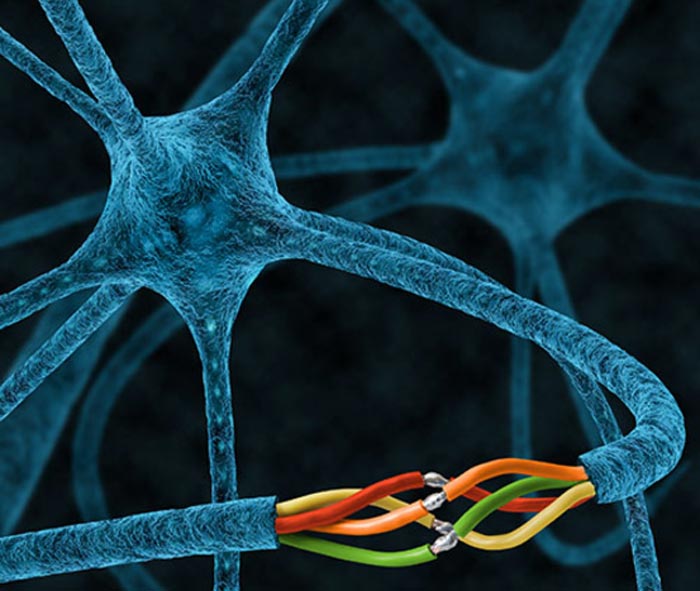What regulates the ‘glue’ needed for nerve repair?

Injured axons of the nematode C. elegans and other invertebrate species are able to rejoin with their separated segments, preventing degeneration and restoring the original axonal tract in a process known as axonal fusion. Ho et al. identify a metalloprotease of the ADAM family, ADM-4, as a key component necessary for axonal fusion to proceed. They reveal that ADM-4 is activated by the lipid phosphatidylserine, and functions by interacting with and stabilizing the fusogen EFF-1 for membrane merging. These findings open the possibility of a better molecular control of axonal fusion that could be exploited in nerve repair in mammals.
Credit: Nick Valmas
Researchers at The University of Queensland have identified a molecule essential for regulating the repair of injured nerves, which could help people recover from nerve damage.
The finding was made using the nematode worm C. elegans which has long been studied by researchers for its ability to self-repair nerve cells.
Professor Massimo Hilliard and his team at UQ’s Queensland Brain Institute (QBI) have identified that the enzyme ADM-4 is an essential protein regulating the molecular glue, or fusogen, needed for nerve repair.
“We have shown that animals lacking ADM-4 cannot repair their nerves by fusion,” Professor Hilliard said.
“ADM-4 must function within the injured neuron to stabilise the fusogen EFF-1 and allow the membranes of the separated nerves to merge.
“An exciting part of this discovery is that ADM-4 is similar to a mammalian gene, opening up the possibility that one day we may harness this process in humans.”
Study first author, Dr Xue Yan Ho, said the nematode provided a great platform for these studies.
“Our goal is to uncover the molecules and understand their role in nerve repair in C. elegans,” Dr Ho said.
“If we can understand how to control this process, we can apply this knowledge to other animal models.
“The hope is that one day, we can induce the same mechanical process in people who have had a nerve injury.
“We are still a long way from this goal, but the discovery of ADM-4’s role is an important step forward.”
Nerve cells communicate using long, cable-like structures called axons.
As they are long and thin, they are very susceptible to breaking, which stops nerve cells from communicating and leads to issues like paralysis.
A few years ago, Professor Hilliard and his team discovered that C. elegans could spontaneously re-join two separated axon fragments, a process called axonal fusion.
QBI’s Associate Professor Victor Anggono helped the team define the molecular mechanisms of this process.
“Using neurosurgery to stitch together damaged nerves has limited success,” A/Professor Anggono said.
“A different approach using gene technology to directly provide the molecular glue, or activate the fusogen regulator ADM-4, or using pharmacology to activate these components, may facilitate complete regeneration.”
This latest research was published in Science Advances.
Journal: Science Advances
DOI: 10.1126/sciadv.abm2882
Method of Research: Experimental study
Article Title: The metalloprotease ADM-4/ADAM17 promotes axonal repair
Article Publication Date: 16-Mar-2022
Media Contact
Natalie MacGregor
University of Queensland
n.macgregor@uq.edu.au
Office: 61-733-651-120
Original Source
All latest news from the category: Health and Medicine
This subject area encompasses research and studies in the field of human medicine.
Among the wide-ranging list of topics covered here are anesthesiology, anatomy, surgery, human genetics, hygiene and environmental medicine, internal medicine, neurology, pharmacology, physiology, urology and dental medicine.
Newest articles

Innovative 3D printed scaffolds offer new hope for bone healing
Researchers at the Institute for Bioengineering of Catalonia have developed novel 3D printed PLA-CaP scaffolds that promote blood vessel formation, ensuring better healing and regeneration of bone tissue. Bone is…

The surprising role of gut infection in Alzheimer’s disease
ASU- and Banner Alzheimer’s Institute-led study implicates link between a common virus and the disease, which travels from the gut to the brain and may be a target for antiviral…

Molecular gardening: New enzymes discovered for protein modification pruning
How deubiquitinases USP53 and USP54 cleave long polyubiquitin chains and how the former is linked to liver disease in children. Deubiquitinases (DUBs) are enzymes used by cells to trim protein…



